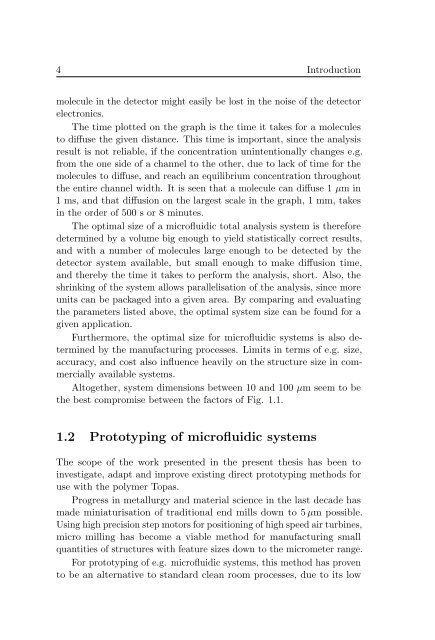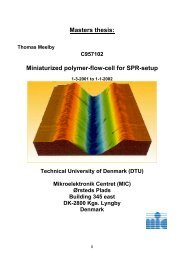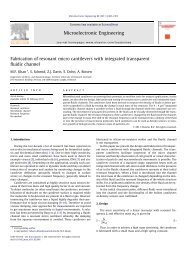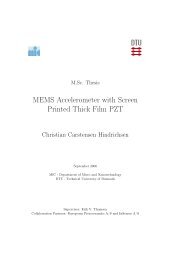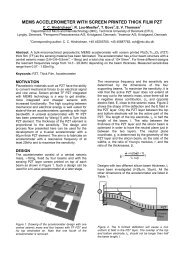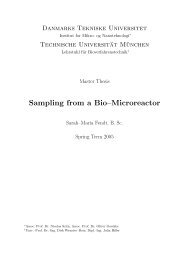Prototyping of microfluidic systems with integrated ... - DTU Nanotech
Prototyping of microfluidic systems with integrated ... - DTU Nanotech
Prototyping of microfluidic systems with integrated ... - DTU Nanotech
Create successful ePaper yourself
Turn your PDF publications into a flip-book with our unique Google optimized e-Paper software.
4 Introduction<br />
molecule in the detector might easily be lost in the noise <strong>of</strong> the detector<br />
electronics.<br />
The time plotted on the graph is the time it takes for a molecules<br />
to diffuse the given distance. This time is important, since the analysis<br />
result is not reliable, if the concentration unintentionally changes e.g.<br />
from the one side <strong>of</strong> a channel to the other, due to lack <strong>of</strong> time for the<br />
molecules to diffuse, and reach an equilibrium concentration throughout<br />
the entire channel width. It is seen that a molecule can diffuse 1 µm in<br />
1 ms, and that diffusion on the largest scale in the graph, 1 mm, takes<br />
in the order <strong>of</strong> 500 s or 8 minutes.<br />
The optimal size <strong>of</strong> a micr<strong>of</strong>luidic total analysis system is therefore<br />
determined by a volume big enough to yield statistically correct results,<br />
and <strong>with</strong> a number <strong>of</strong> molecules large enough to be detected by the<br />
detector system available, but small enough to make diffusion time,<br />
and thereby the time it takes to perform the analysis, short. Also, the<br />
shrinking <strong>of</strong> the system allows parallelisation <strong>of</strong> the analysis, since more<br />
units can be packaged into a given area. By comparing and evaluating<br />
the parameters listed above, the optimal system size can be found for a<br />
given application.<br />
Furthermore, the optimal size for micr<strong>of</strong>luidic <strong>systems</strong> is also determined<br />
by the manufacturing processes. Limits in terms <strong>of</strong> e.g. size,<br />
accuracy, and cost also influence heavily on the structure size in commercially<br />
available <strong>systems</strong>.<br />
Altogether, system dimensions between 10 and 100 µm seem to be<br />
the best compromise between the factors <strong>of</strong> Fig. 1.1.<br />
1.2 <strong>Prototyping</strong> <strong>of</strong> micr<strong>of</strong>luidic <strong>systems</strong><br />
The scope <strong>of</strong> the work presented in the present thesis has been to<br />
investigate, adapt and improve existing direct prototyping methods for<br />
use <strong>with</strong> the polymer Topas.<br />
Progress in metallurgy and material science in the last decade has<br />
made miniaturisation <strong>of</strong> traditional end mills down to 5 µm possible.<br />
Using high precision step motors for positioning <strong>of</strong> high speed air turbines,<br />
micro milling has become a viable method for manufacturing small<br />
quantities <strong>of</strong> structures <strong>with</strong> feature sizes down to the micrometer range.<br />
For prototyping <strong>of</strong> e.g. micr<strong>of</strong>luidic <strong>systems</strong>, this method has proven<br />
to be an alternative to standard clean room processes, due to its low


